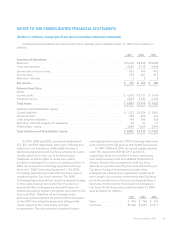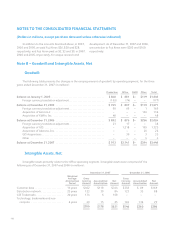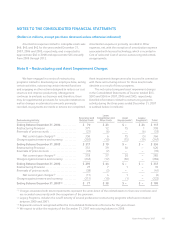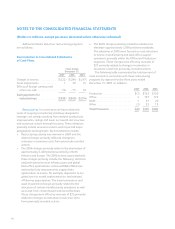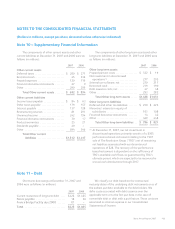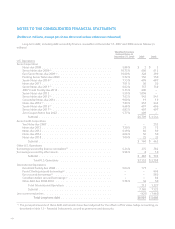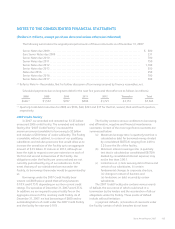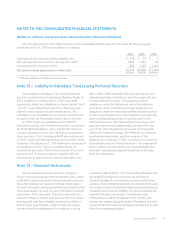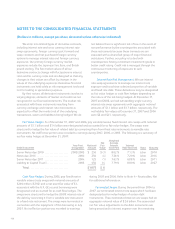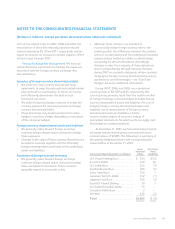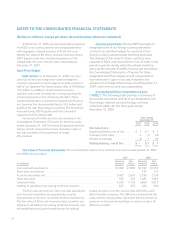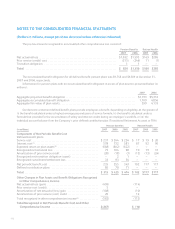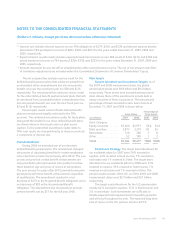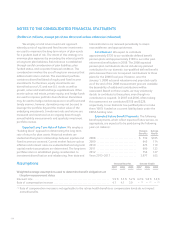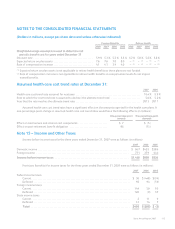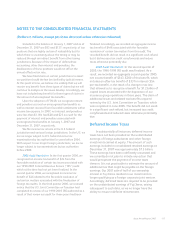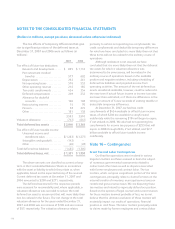Xerox 2007 Annual Report Download - page 110
Download and view the complete annual report
Please find page 110 of the 2007 Xerox annual report below. You can navigate through the pages in the report by either clicking on the pages listed below, or by using the keyword search tool below to find specific information within the annual report.
NOTES TO THE CONSOLIDATED FINANCIAL STATEMENTS
(Dollars in millions, except per-share data and unless otherwise indicated)
We enter into limited types of derivative contracts,
including interest rate and cross currency interest rate
swap agreements, foreign currency spot, forward and
swap contracts and net purchased foreign currency
options to manage interest rate and foreign currency
exposures. Our primary foreign currency market
exposures include the Japanese Yen, Euro, and British
pound sterling. The fair market values of all our
derivative contracts change with fluctuations in interest
rates and/or currency rates and are designed so that any
changes in their values are offset by changes in the
values of the underlying exposures. Derivative financial
instruments are held solely as risk management tools and
not for trading or speculative purposes.
By their nature, all derivative instruments involve, to
varying degrees, elements of market and credit risk not
recognized in our financial statements. The market risk
associated with these instruments resulting from
currency exchange and interest rate movements is
expected to offset the market risk of the underlying
transactions, assets and liabilities being hedged. We do
not believe there is significant risk of loss in the event of
non-performance by the counterparties associated with
these instruments because these transactions are
executed with a diversified group of major financial
institutions. Further, our policy is to deal with
counterparties having a minimum investment-grade or
better credit rating. Credit risk is managed through the
continuous monitoring of exposures to such
counterparties.
Interest Rate Risk Management: We use interest
rate swap agreements to manage our interest rate
exposure and to achieve a desired proportion of variable
and fixed rate debt. These derivatives may be designated
as fair value hedges or cash flow hedges depending on
the nature of the risk being hedged. At December 31,
2007 and 2006, we had outstanding single currency
interest rate swap agreements with aggregate notional
amounts of $1.1 billion and $1.7 billion, respectively. The
net liability fair values at December 31, 2007 and 2006
were $6 and $41, respectively.
Fair Value Hedges: As of December 31, 2007 and 2006, pay variable/receive fixed interest rate swaps with notional
amounts of $1.1 billion and $1.4 billion were designated and accounted for as fair value hedges. The swaps were
structured to hedge the fair value of related debt by converting them from fixed rate instruments to variable rate
instruments. No ineffective portion was recorded to earnings during 2007, 2006, or 2005. The following is a summary of
our fair value hedges at December 31, 2007:
Debt Instrument Year First
Designated Notional
Amount
Net
Fair
Value
Weighted
Average
Interest
Rate Paid Interest
Rate Received Basis Maturity
Senior Notes due 2010 ................... 2003/2005 $ 250 $ (3) 8.02% 7.13% Libor 2010
Notes due 2016 ......................... 2004 250 (4) 7.28% 7.20% Libor 2016
Senior Notes due 2011 ................... 2004 125 (1) 7.63% 6.88% Libor 2011
Liability to Capital Trust I ................. 2005 450 14 7.79% 8.00% Libor 2027
Total ............................... $1,075 $ 6
Cash Flow Hedges: During 2006, pay fixed/receive
variable interest rate swaps with notional amounts of
£200 million ($392) and a net asset fair value of $1,
associated with the U.K. GE secured borrowing were
designated and accounted for as cash flow hedges. The
swaps were structured to hedge the LIBOR interest rate of
the debt by converting it from a variable rate instrument
to a fixed rate instrument. The swaps were terminated in
connection with the repayment of this borrowing in July
2007. No ineffective portion was recorded to earnings
during 2007 and 2006. Refer to Note 4 – Receivables, Net
for additional information.
Terminated Swaps: During the period from 2004 to
2007, we terminated interest rate swaps which had been
designated as fair value hedges of certain debt
instruments. These terminated interest rate swaps had an
aggregate notional value of $2.6 billion. The associated
net fair value adjustments to the debt instruments are
being amortized to interest expense over the remaining
108



